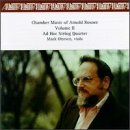| All Artists: Arnold Rosner, Ad Hoc String Quartet Title: Chamber Music of Arnold Rosner, Vol. 2 Members Wishing: 0 Total Copies: 0 Label: Albany Records Release Date: 1/14/1997 Genre: Classical Style: Chamber Music Number of Discs: 1 SwapaCD Credits: 1 UPC: 034061021025 |
Search - Arnold Rosner, Ad Hoc String Quartet :: Chamber Music of Arnold Rosner, Vol. 2
 | Arnold Rosner, Ad Hoc String Quartet Chamber Music of Arnold Rosner, Vol. 2 Genre: Classical
|
Larger Image |
CD Details |
CD ReviewsThe Intricate Accessibility of Arnold Rosner Thomas F. Bertonneau | Oswego, NY United States | 08/15/2001 (4 out of 5 stars) "Not a household name, Arnold Rosner (born 1945) has remained outside of the musical center-stage during much of his career even while creating a large body of music, at odds with the times, that seems increasingly likely to find an audience. Before others made it fashionable, Rosner had espoused a style that we now call Neo-Romanticism, although in Rosner's case the prefix might be redundant. The tonal vocabulary, the appreciation of audibly clear form, the insistence on melody - all of this seems to flow naturally from Rosner's genius, and the music never seems contrived or inauthentic. One hears echoes of other composers, particularly of Ernest Bloch in the occasional cantillatory episodes and in the predominace of Eastern modes, perhaps also of Alan Hovhannes, but Rosner assimilates his influences. The Albany disc of Rosner's string quartets makes a good introduction to his compositorial world. The "Ad Hoc" instrumentalists play String Quartets Nos. 2 (1963), 3 (1965, revised 1992), and 5 (1977). A Duet for Violas (1977) fills out the disc. The Second and Fifth Quartets unfold as single movements subdivided by varying tempi; the Third Quartet is in three separate movements. Rosner had not yet attained his eighteenth year when he wrote the Second Quartet (A Minor), whose fifteen-minute span covers (in seamless fashion) a shifting sequence of moods. One or two moments anticipate minimalism - the insistent rocking figure that begins the section marked Allegro Scherzando - but the whole, of course, makes a much more traditional impression. That same insistent rocking figure crops up as an important element of the Fifth Quartet (D Minor). Rosner's is a tonal music of continuous development. The closest formal model for these two one-movement quartets probably lies in the orchestral "Essays" of Samuel Barber and behind those the one-movement sonata-structures of Franz Liszt and the early Arnold Schoenberg (of the Chamber Symphonies). The Third Quartet works within a contemplative atmosphere, employs a subtle polyphony, and gives an impression overall of quiet intensity. The First Movement, a tripartite Moderato / Allegro / Moderato, begins with a canon on a chant-like motif; the faster middle section is fugal, after which the opening Moderato returns to undergo renewed development. The dance-like Second Movement (Allegretto) evokes shades of the Renaissance; these tunes would not sound inappropriate played by a band of sackbuts and shawms. The Third Movement's sequence of moods inverts that of the First: Allegro con Brio / Andante / Allegro con Brio. The slow middle section seems to recall the chant-like motif that opens the First Movement. The Third Quartet is thus "cyclic" in character, rather like those of Ernest Bloch. The Duo for Violas operates in the same manner as the quartets. It might well be a movement from one of the quartets, although the texture is not so wide given the instrumentation. On the strength of these works, I should like to hear the two remaining quartets and, indeed, other works by Rosner - what does he do with an orchestra?"
|

 Track Listings (6) - Disc #1
Track Listings (6) - Disc #1